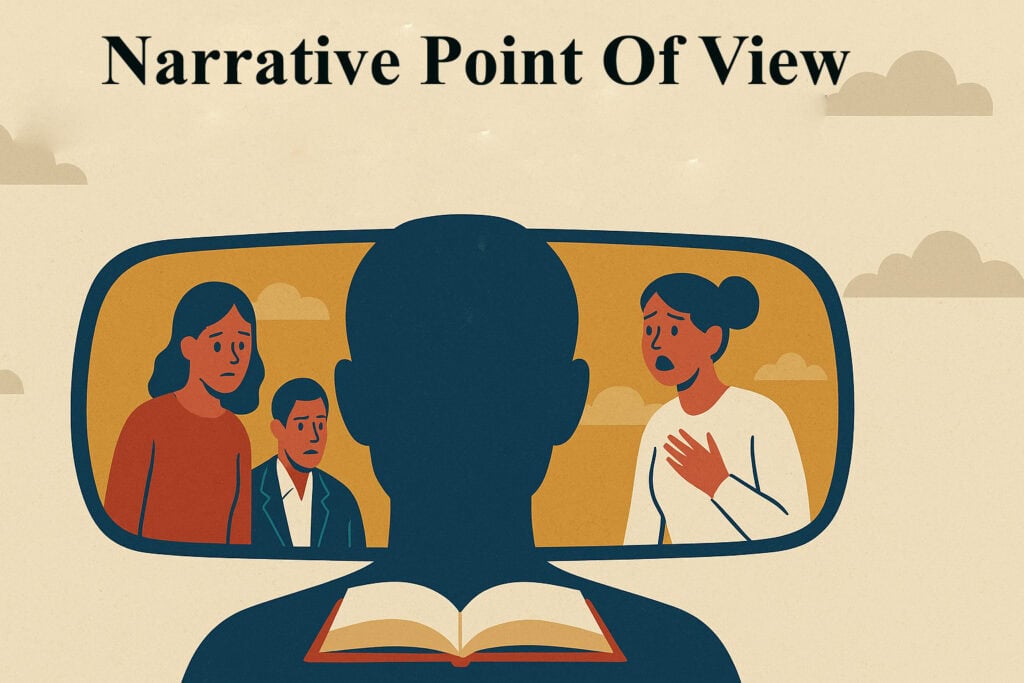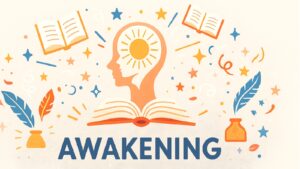Table of Contents
Introduction: Narrative Point of View is The Emotional Lens of Every Story
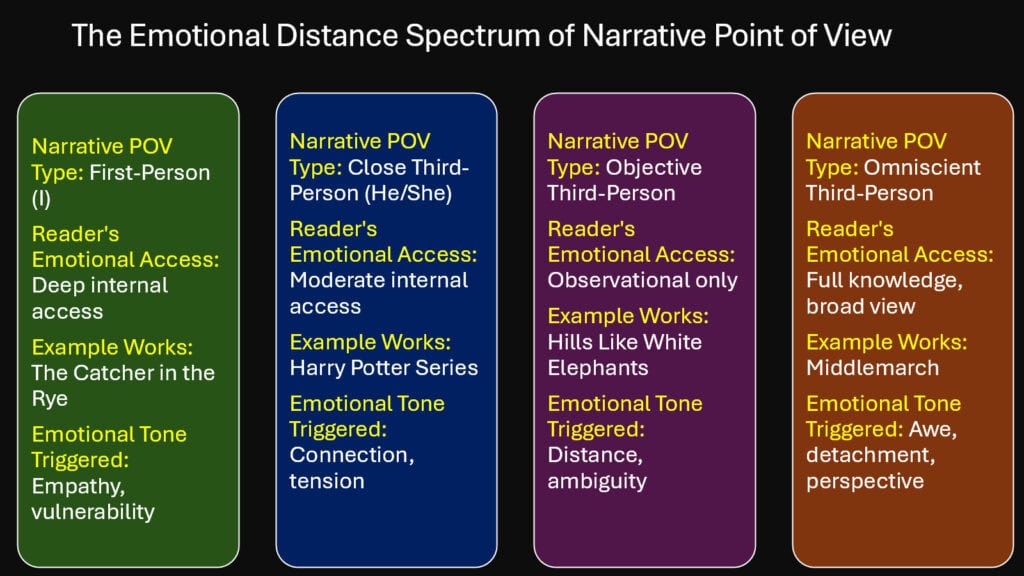
When Virginia Woolf wrote Mrs. Dalloway, she made a choice that would forever change how readers experience fiction. She decided to slip inside Clarissa’s mind, letting us feel her thoughts as if they were our own. This wasn’t just a writing technique—it was an emotional strategy. Narrative point of view shapes every feeling we have while reading, from the first page to the last.
Think of narrative point of view as the camera through which we see a story unfold. Just as a close-up shot creates intimacy while a wide shot suggests distance, different narrative perspectives control how deeply we feel what characters experience. The voice telling the story becomes our guide, our filter, our emotional compass. It decides what we know, when we know it, and how we feel about it.
Writers understand this power. They know that choosing first person over third person isn’t just about grammar—it’s about emotion. When Harper Lee chose Scout to narrate To Kill a Mockingbird, she gave readers a child’s wonder mixed with an adult’s understanding. When Gillian Flynn used multiple perspectives in Gone Girl, she created emotional whiplash that mirrors the toxic relationship at the story’s heart.
Narrative point of view operates through six distinct emotional mechanisms. First, it builds empathy by placing readers inside characters’ minds. Second, it transforms readers into co-creators of meaning through their responses to different narrative voices. Third, it creates disorientation through unreliable or fragmented perspectives. Fourth, it establishes emotional distance that can evoke awe or melancholy. Fifth, it shifts between perspectives to create contrasts and surprises. Finally, it channels ideological emotions by subtly shaping what readers consider normal or strange.
These six pathways work together to create the emotional architecture of every story. They determine whether we laugh, cry, feel suspense, or experience that strange mix of satisfaction and sadness that comes at the end of a powerful book.
Table 1: Emotional Functions of Different Narrative Point of View
| Types of Narrative Point of View | Primary Emotional Effect | Reader Experience | Literary Examples |
|---|---|---|---|
| First Person | Intimate connection | Direct access to thoughts | The Catcher in the Rye |
| Close Third Person | Controlled empathy | Filtered emotional access | Harry Potter series |
| Omniscient Third | Emotional distance | Broader understanding | War and Peace |
| Multiple Perspectives | Emotional complexity | Shifting loyalties | The Sound and the Fury |
| Unreliable Narrator | Uncertainty and tension | Questioning reality | Lolita |
1. Narrative Point of View and the Power of Empathy
The most direct way narrative point of view invokes emotion is through empathy. When readers encounter first-person narration or close third-person perspective, they don’t just observe characters—they inhabit them. This inhabitation creates an emotional bond that can feel more real than our connections to actual people.
Consider how J.D. Salinger evokes empathy in The Catcher in the Rye. Holden Caulfield’s voice engages readers so intimately that we perceive his thoughts as our own internal dialogue. When he claims that everyone around him is insincere, we do not merely comprehend his sense of alienation—we experience it. The first-person viewpoint renders his suffering immediate and personal. Readers frequently express feelings of protectiveness towards Holden, even when they disagree with his choices.
Close third-person narration works similarly but with more control. In the Harry Potter series, J.K. Rowling limits readers to Harry’s perspective while maintaining narrative distance. This technique lets readers experience Harry’s emotions without losing sight of the larger story. When Harry feels confused about Snape’s motivations, readers share that confusion. When he experiences triumph, readers celebrate with him.
The empathy created by narrative point of view goes beyond simple identification. It actually changes how readers process information. Psychologist Keith Oatley’s research shows that when readers connect emotionally with characters through close narrative perspectives, they demonstrate increased empathy in real-world situations. The brain processes fictional experiences similarly to actual experiences when the narrative point of view creates strong emotional connections.
This empathetic reaction varies depending on the narrator’s self-presentation. A vulnerable narrator such as Scout Finch in To Kill a Mockingbird elicits protective sentiments. Conversely, a self-assured narrator like Elizabeth Bennet in Pride and Prejudice inspires a blend of admiration and concern. The narrative voice evolves into a persona that readers emotionally connect with.
Table 2: Empathy-Building Techniques in Narrative Point of View
| Technique | Emotional Mechanism | Reader Response | Classic Example |
|---|---|---|---|
| Internal monologue | Direct thought access | Intimate understanding | Stream of consciousness |
| Emotional vulnerability | Shared pain/joy | Protective feelings | Coming-of-age narratives |
| Limited knowledge | Shared confusion | Collaborative discovery | Mystery perspectives |
| Personal stakes | Investment in outcomes | Emotional investment | Hero’s journey narratives |
| Authentic voice | Personality connection | Character friendship | Distinctive narrators |
2. Narrative Point of View as a Reflection of the Reader’s Role
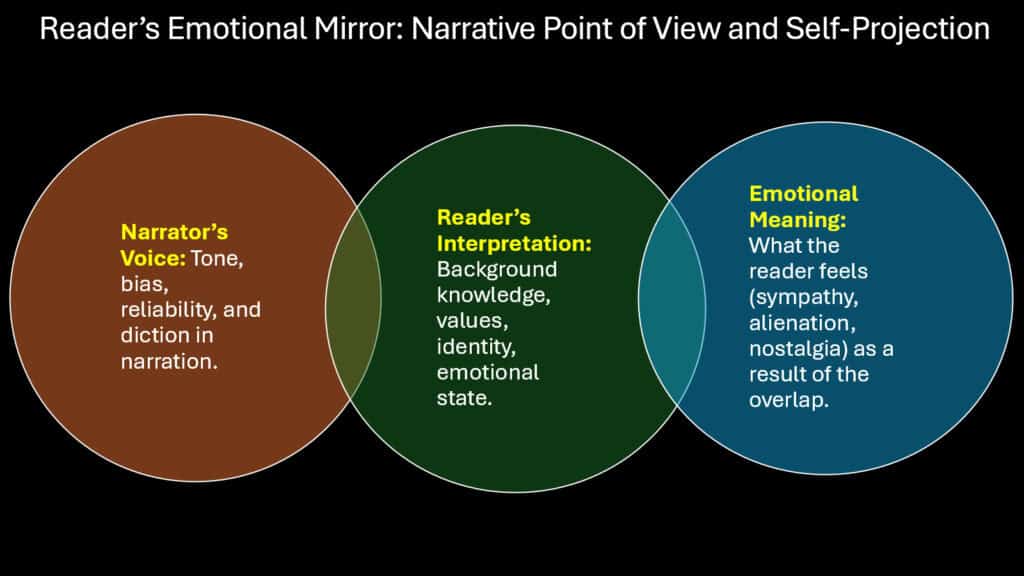
Reader-Response Theory reveals how narrative point of view transforms readers from passive consumers into active creators of emotional meaning. Different narrative perspectives invite different types of emotional participation. When readers encounter various narrative voices, they don’t just receive information—they interpret, judge, and emotionally respond based on their own experiences and perspectives.
Wolfgang Iser’s work on implied readers shows how narrative point of view creates spaces for reader participation. A distant omniscient narrator invites readers to fill emotional gaps with their own feelings. An unreliable first-person narrator forces readers to become emotional detectives, deciding what to trust and what to question. Each narrative choice creates different opportunities for emotional co-creation.
Consider how Toni Morrison uses narrative point of view in Beloved. The shifting perspectives and fragmented storytelling require readers to piece together not just plot details but emotional truths. Readers must decide how to feel about Sethe’s actions, how to interpret Baby Suggs’ wisdom, how to understand the community’s response to tragedy. The narrative point of view makes readers emotional participants in the story’s moral complexity.
This participation creates deeper emotional investment than straightforward storytelling. When readers must work to understand a character’s motivations through limited or biased narrative perspectives, they develop stronger feelings about the outcomes. The effort required to interpret emotional cues makes the eventual understanding more satisfying and memorable.
Louise Rosenblatt’s transactional theory explains how this emotional co-creation works. Readers bring their own emotional experiences to every narrative encounter. A narrative point of view that allows space for interpretation lets readers project their own feelings onto characters and situations. This projection creates personal emotional stakes in fictional outcomes.
Table 3: Reader-Response Emotional Patterns in Narrative Point of View
| Narrative Approach | Reader’s Emotional Role | Interpretive Challenge | Emotional Outcome |
|---|---|---|---|
| Gap-filled narration | Emotional detective | Inferring feelings | Personal investment |
| Ambiguous perspective | Moral judge | Evaluating actions | Complex sympathy |
| Multiple viewpoints | Emotional mediator | Reconciling differences | Nuanced understanding |
| Limited information | Collaborative discoverer | Sharing uncertainty | Shared revelation |
| Biased narrator | Critical reader | Questioning reliability | Independent judgment |
3. Narrative Point of View and Emotional Disorientation
Some narrative points of view deliberately create emotional chaos rather than clarity. Unreliable narrators and fragmented perspectives can evoke confusion, dread, and obsession by denying readers the stable emotional foundation they expect from storytelling. This disorientation becomes its own powerful emotional experience.
Edgar Allan Poe excelled in this technique in works such as The Tell-Tale Heart. The narrator asserts his sanity while detailing progressively irrational actions. Readers confront the disquieting truth that they cannot rely on their guide throughout the narrative. This engenders a sense of anxiety that reflects the narrator’s psychological condition. The narrative perspective transforms into a snare from which readers cannot break free.
Modern writers have expanded this technique. In Fight Club, Chuck Palahniuk uses an unreliable first-person narrator who doesn’t understand his own situation. Readers gradually realize they know more about the narrator than he knows about himself. This creates a strange mixture of superiority and sympathy—readers feel both smarter than the narrator and worried about his fate.
Fragmented narrative perspectives create different types of emotional disorientation. In The Sound and the Fury, William Faulkner presents the same events through different characters’ perspectives, including Benjy’s intellectually disabled viewpoint. Readers must emotionally navigate between radically different ways of understanding the same situation. The confusion becomes part of the emotional experience, reflecting the family’s dysfunction.
These disorienting narrative techniques work because they mirror real emotional experiences. Life often feels confusing and unreliable. When narrative point of view reflects this uncertainty, readers recognize the authenticity even as they feel uncomfortable. The discomfort becomes emotionally meaningful rather than simply frustrating.
Table 4: Emotional Disorientation Techniques in Narrative Point of View
| Disorientation Method | Emotional Effect | Reader Challenge | Literary Function |
|---|---|---|---|
| Unreliable narrator | Anxiety and mistrust | Questioning truth | Psychological realism |
| Fragmented timeline | Temporal confusion | Reconstructing events | Memory representation |
| Multiple contradictions | Cognitive dissonance | Reconciling differences | Complex truth |
| Limited comprehension | Interpretive burden | Filling knowledge gaps | Authentic limitation |
| Shifting reliability | Emotional instability | Constant reevaluation | Dynamic understanding |
4. Narrative Point of View and Emotional Distance
Structuralism, particularly Tzvetan Todorov’s work on narrative structure, helps explain how third-person omniscient and detached narration creates emotional distance that can evoke awe, melancholy, or tension. This distance doesn’t eliminate emotion—it transforms it into something more contemplative and universal.
Leo Tolstoy demonstrates this technique throughout War and Peace. The omniscient narrator pulls back from individual characters to comment on the nature of history, war, and human behavior. This distance creates a sense of awe at the scope of human experience. Readers feel both small in comparison to historical forces and elevated by understanding them. The emotional effect is philosophical rather than personal.
Gabriel García Márquez uses similar techniques in One Hundred Years of Solitude. The detached, chronicle-like narration treats extraordinary events as matter-of-fact occurrences. This creates emotional distance that makes magical events feel inevitable rather than surprising. The narrative point of view implies that personal human experiences are components of broader, cyclical patterns.
Emotional distance through narrative point of view can also create melancholy. When narrators describe characters’ lives from a removed perspective, readers feel the poignancy of human limitation. We see characters making mistakes or missing opportunities that the broader perspective reveals. This creates a bittersweet emotional experience—understanding mixed with sadness.
The structural approach to narrative shows how this distance manipulates time and knowledge. Omniscient narrators can reveal future consequences of present actions, creating dramatic irony. They can compare characters across different time periods, highlighting the temporary nature of individual concerns. This temporal manipulation creates complex emotional responses that combine immediate sympathy with broader perspective.
Table 5: Emotional Distance Effects in Omniscient Narrative Point of View
| Distance Technique | Emotional Quality | Temporal Manipulation | Reader Experience |
|---|---|---|---|
| Historical scope | Awe and smallness | Long-term perspective | Philosophical contemplation |
| Multiple generations | Cyclical melancholy | Generational patterns | Universal recognition |
| Dramatic irony | Tragic awareness | Future knowledge | Protective concern |
| Cultural commentary | Analytical detachment | Social observation | Critical understanding |
| Cosmic perspective | Existential wonder | Infinite scope | Humbling recognition |
5. Narrative Point of View and Shifting Emotional Perspectives
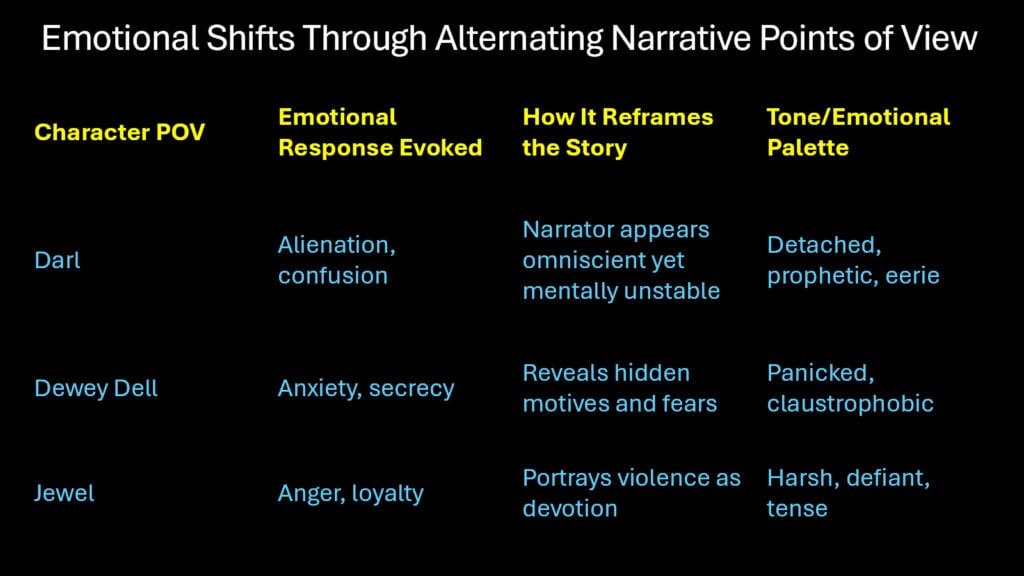
Alternating narrative points of view create emotional contrasts that can surprise, betray, or provide relief by reframing events through different emotional lenses. Each new voice brings a different emotional palette, changing how readers understand and feel about the same events.
Gillian Flynn’s Gone Girl exemplifies this technique perfectly. The alternating perspectives of Nick and Amy create emotional whiplash that reflects their toxic relationship. Readers initially sympathize with Nick as he searches for his missing wife, then feel betrayed when Amy’s perspective reveals her manipulation. The shifting points of view mirror the emotional manipulation within the marriage itself.
William Faulkner uses multiple perspectives differently in As I Lay Dying. Each family member’s chapter reveals their unique emotional relationship to Addie’s death and the journey to bury her. The shifting perspectives show how the same events can evoke completely different emotions depending on individual circumstances and personalities. Readers experience the full spectrum of grief, duty, resentment, and love within a single family.
This technique works because it reflects real-world emotional complexity. The same event can seem tragic from one perspective and comic from another. By shifting narrative points of view, writers can explore this complexity without requiring readers to hold contradictory emotions simultaneously. Instead, readers experience emotional evolution as they encounter different viewpoints.
The surprise element of shifting perspectives creates particularly powerful emotional effects. When readers have invested emotionally in one character’s perspective, encountering a contradictory viewpoint can feel like betrayal or revelation. This emotional shock often leads to deeper understanding of all characters involved.
Table 6: Emotional Effects of Shifting Narrative Point of View
| Shifting Pattern | Emotional Dynamic | Reader Experience | Narrative Purpose |
|---|---|---|---|
| Contradictory views | Betrayal and revelation | Emotional whiplash | Complex truth |
| Complementary perspectives | Enhanced understanding | Layered sympathy | Complete picture |
| Opposing loyalties | Conflicted allegiance | Moral complexity | Ethical ambiguity |
| Temporal shifts | Evolving emotions | Character development | Growth representation |
| Social contrasts | Class consciousness | Cultural awareness | Social commentary |
6. Narrative Point of View as a Channel for Ideological Emotion
Critical Discourse Analysis reveals how the narrative point of view subtly shapes emotional responses to social values and worldviews. The narrator’s lens frames what readers consider normal or strange, desirable or tragic, often without readers realizing this emotional guidance is happening.
Jane Austen’s narrative voice in Pride and Prejudice demonstrates this subtle ideological channeling. The narrator’s gentle irony guides readers toward particular emotional responses to different social behaviors. When describing Mr. Collins’s pompous speeches, the narrative tone suggests amusement rather than respect. When presenting Elizabeth’s independent thinking, the tone suggests admiration rather than concern. These emotional cues shape readers’ values about social conformity and individual agency.
Norman Fairclough’s work on critical discourse analysis shows how everyday language choices in narrative carry implicit stances. A narrator who describes poverty as “unfortunate circumstances” evokes different emotions than one who calls it “systemic oppression.” The narrative point of view doesn’t argue for these positions—it makes them feel natural through word choice and tone.
The ideological role of narrative point of view functions through cultural assumptions that are ingrained in language. When a narrator describes certain behaviors as “natural” or “obvious,” readers absorb these value judgments along with the story. The emotional responses these descriptions evoke feel personal but actually reflect broader social attitudes channeled through the narrative voice.
Contemporary writers often use this technique deliberately to challenge readers’ assumptions. Chimamanda Ngozi Adichie’s narrative choices in Americanah guide readers toward particular emotional responses to racism and cultural difference. The point of view doesn’t lecture about these issues—it makes readers feel the emotional reality of cultural displacement and prejudice.
Table 7: Ideological Emotional Channeling Through Narrative Point of View
| Ideological Element | Emotional Guidance | Language Technique | Reader Response |
|---|---|---|---|
| Social class attitudes | Superiority or sympathy | Descriptive tone | Class consciousness |
| Gender expectations | Approval or resistance | Character presentation | Value formation |
| Cultural norms | Comfort or unease | Behavioral framing | Social alignment |
| Power structures | Acceptance or challenge | Authority portrayal | Political emotion |
| Moral frameworks | Right or wrong feelings | Ethical implications | Conscience development |
Conclusion: Narrative Point of View Feels, Remembers, and Reveals
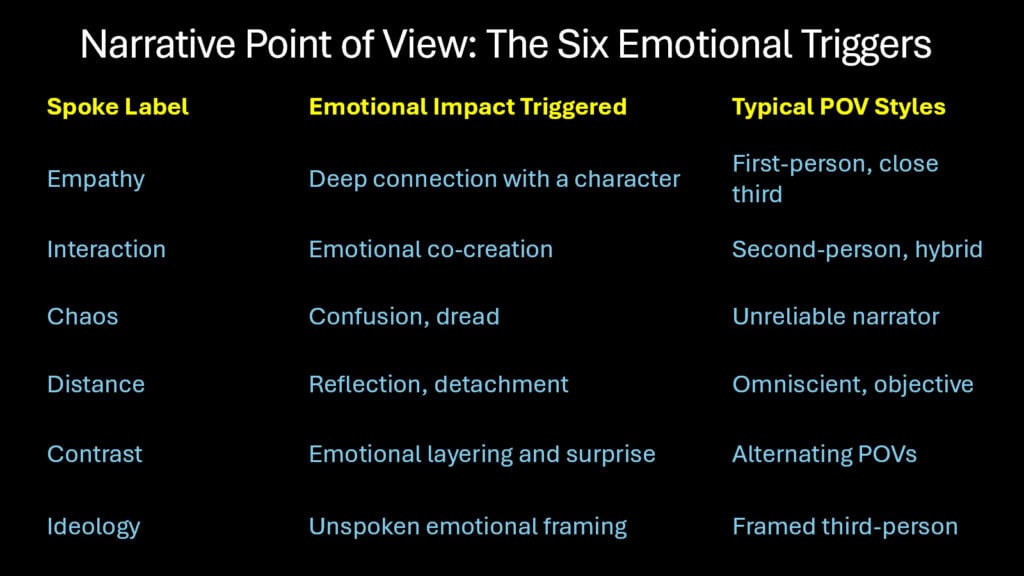
Narrative point of view does far more than determine who tells a story—it controls how that story feels. Through the six emotional pathways explored in this analysis, narrative perspective shapes every aspect of the reading experience. It builds empathy through intimate access to characters’ inner lives. It transforms readers into emotional co-creators through interpretive challenges. It generates significant disorientation that reflects the unpredictability of life. It establishes distance that enables philosophical contemplation. It shifts between perspectives to reveal emotional complexity. It channels ideological emotions through subtle value guidance.
These emotional functions work together to create the lasting impact of powerful literature. When readers remember a book years after reading it, they often recall how it made them feel rather than specific plot details. That emotional memory comes largely from the ability of the narrative point of view to create not just a story, but an emotional experience.
The sophistication of narrative point of view as an emotional tool continues to evolve. Contemporary writers experiment with new forms of narrative point of view, including second-person narration, collective voices, and fragmented digital storytelling. Each innovation creates new possibilities for emotional connection between readers and stories.
Understanding these emotional mechanisms helps both writers and readers appreciate the craft behind powerful storytelling. Writers can make more deliberate choices about how they want readers to feel. Readers can recognize how their emotions are being shaped and choose whether to embrace or resist that guidance.
The relationship between narrative point of view and emotion reveals something fundamental about human nature. We understand ourselves and others through stories, and the perspective from which those stories are told shapes our emotional reality. In this sense, narrative point of view is not just a literary technique—it’s a way of being human.
Table 8: Synthesis of Narrative Point of View Emotional Effects
| Emotional Function | Primary Mechanism | Reader Transformation | Literary Impact |
|---|---|---|---|
| Empathy building | Intimate identification | Personal investment | Character bonding |
| Co-creation | Interpretive participation | Active engagement | Meaning ownership |
| Disorientation | Reliability challenges | Emotional uncertainty | Psychological realism |
| Distance | Philosophical perspective | Contemplative understanding | Universal insight |
| Contrast | Multiple viewpoints | Complex sympathy | Nuanced judgment |
| Ideology | Value channeling | Social alignment | Cultural influence |
Read More Storytelling Articles
- 6 Ways Narrative Resolution Brings Psychological Closure
- 6 Ways Narrative Conflicts Spark Epic Worldbuilding
- 6 Amazing Ways Characters in A Story Create Grandeur
- Explore Mahabharata’s 6 Genius Storytelling Techniques
- Iliad’s 6 Bold Storytelling Techniques That Grip You
- Heike Monogatari: 6 Vivid Techniques for Epic Storytelling

